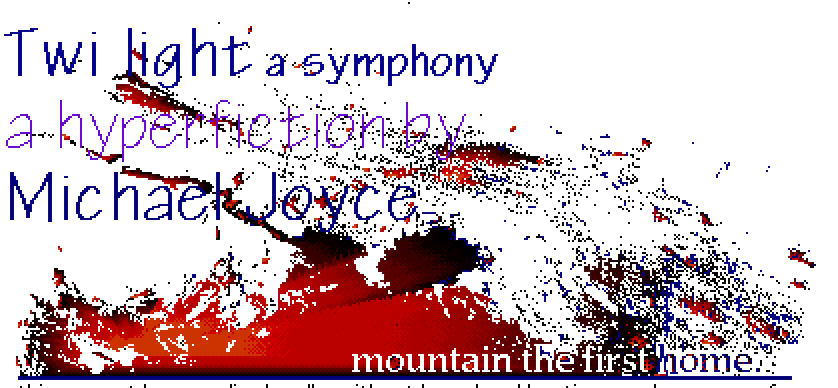
online version by Mariusz Pisarski
programming: Michał Furgał
graphics: Łukasz Podgórni
usability feedback and consultation: John Barber
predecessor code: Jakub Jagiełło
MICHAEL JOYCE'S CREDITS FROM STORYSPACE VERSION
Original QuickTime™ movie “after,noon”
by Kate Wharmby, Alison Klensch, and Brigitte Hales @1995;
Visual effects, image treatment, and editing
M. Joyce;
Soundtrack music from “2 trips later”
©SPARK, 1995, Lucky Artists Records, Poughkeepsie, NY, used by permission from these young artists and friends.
The Josselyn font © 1994 by Michael Sugarbaker
is used by permission of this young artist and friend who distributes this font freely through various public sources.
I am grateful to him for asking why the hyperfiction writers did not explore graphics fonts[The online versions features screenshots of the original font apperances, v08300821, MP]
Mireille Rosello quote from “The Screener’s Maps” .
in Hyper/Text/Theory. Ed. George Landow, Johns Hopkins University Press, Baltimore. 1994.
Robert Coover’s dialogue
from an interview with Larry McCaffery, 1983.
Glenn Gould’s dialogue
from “The Record of the Decade,” 1968. Some of Umberto Eco’s dialogue from “Cogito Interruptus,” 1967.
“A: death” border
adapted from a painting by Carolyn Guyer.
HC’s eyes.
“Truisms” ©Jenny Holzer used without permission but with gratitude in a productive and transformative fashion which does not materially impair the marketability of the work partly under fair use in a satiric manner and partly under incidental use in order to engage, among artists and our audiences, the issues of copyright and new media. (Get a Holzer teeshirt; write something nice somewhere unexpected.)
“On the One Road” ©The Wolfe Tones,
sampled from Let the People Sing ©Shanachie Records #52031, used incidentally and without permission although not as a performance in itself but rather in a productive and transformative fashion which does not materially impair the marketability of the work and with gratitude as part of a hypermedia allusion and an evocation of a fading race.
(Up the rebels. British, let the peace process continue. God bless the Wolfe Tones and Shanachie. Buy their records and tapes!)
“A Musical Eccentric’s Quirks And Talent,” a film review
by Janet Maslin ©The New York Times , from the America Online electronic edition, Apr. 14, 1994, is used in its entirety and without permission but with gratitude in a productive and transformative fashion as incidental use as an instance of an electronic document among other such fictional and actual electronic documents which does not materially impair the marketability of the already published journalistic work.
A selection from Umberto Eco
“On the Crisis of the Crisis of Reason”, Travels in Hyperreality, translated from the Italian by William Weaver, @1986 Harcourt Brace Jovanovich as well as the boilerplate copyright disclaimer which requires permission both used without permission in a productive and transformative fashion which does not materially impair the marketability of the work and in a context so clearly satirical and thus within fair use that I probably shouldn’t even mention it here.
A copyrighted image of the clouds has been
treated and filtered and such and used without permission or attribution but in a productive and transformative fashion in the belief that some things (the clouds for instance) are, Obie, free to see.
Twilight, a symphony ©Michael Joyce 1995
Please feel free to use portions under fair use and within the kinds of dialogues, allusions and evocations described above but people like Eastgate, Holzer, Shanachie and (god knows) the Wolfe Tones have taken the risks (human, artistic, financial) and in most cases are barely hanging on and so they deserve (and often need) what comes to them under copyright.
And so: all rights reserved.
Special thanks to Diane Greco, a caring and careful editor, and to Mark Bernstein, a gentle man and a scholar, the James Laughlin of electronic publishing. This fiction owes much to John McDaid’s extraordinary and groundbreaking hyperfiction, Uncle Buddy’s Phantom Funhouse , also published by Eastgate Systems 134 Main Street Watertown, MA 02172 1.800.562.1638 1.617.924.9044 In fact everything started with TINAC: John and Nancy and Stuart and Jane and, especially, Jay and Mary (O Caro) Jeremiah and Eamon give me life.
to start press "enter" or use button
ELL Lab & Techsty 2021